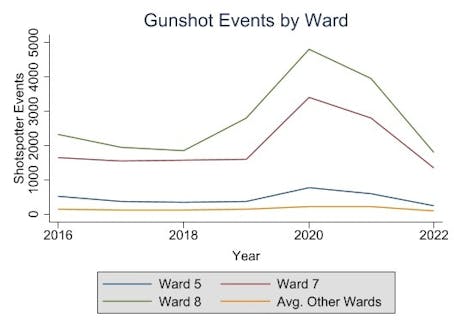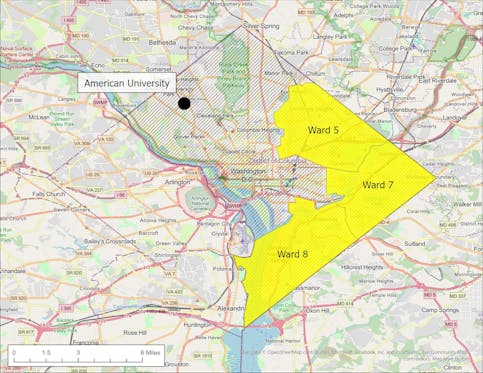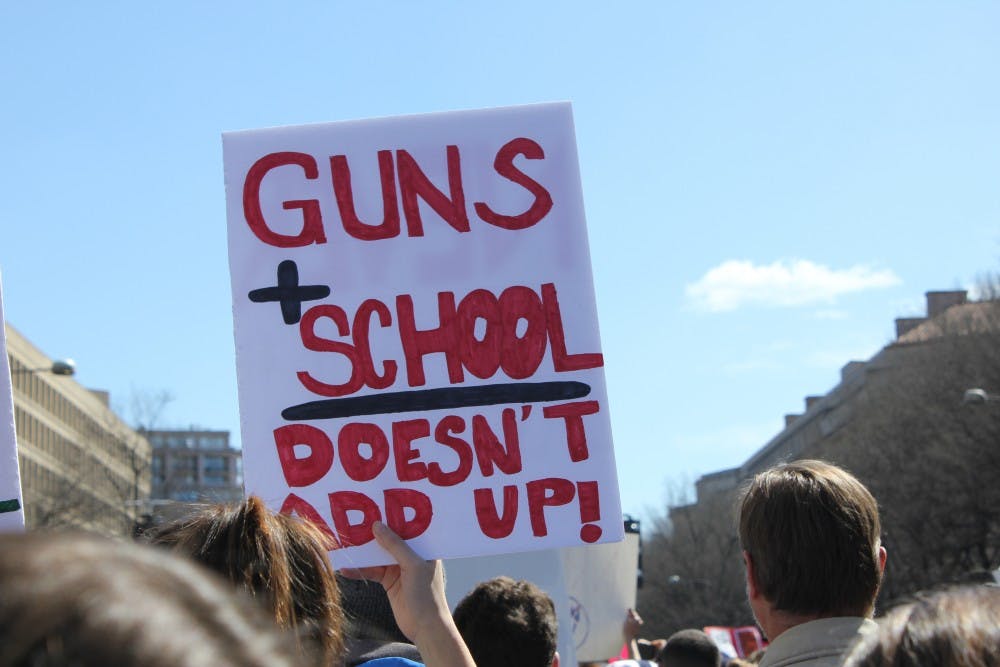One week into 2023, a 13-year-old boy named Karon Blake was fatally shot in the Brookland neighborhood in Northeast D.C. The next week, one woman was killed and another teenager and man were injured in a shooting in the district’s Benning Ridge neighborhood. At the start of February, D.C. Metro worker Robert Cunningham was killed and three passengers were injured during yet another shooting, this time in the Potomac Avenue Metro station.
Overall, homicides are up 33 percent in the district from this time last year, according to the Metropolitan Police Department.
Shootings in D.C. follow a larger national trend of rising rates of gun violence, with nearly 8,000 shooting deaths since the beginning of the year, according to the Gun Violence Archive, an online log of gun violence incidents that provides “near-real time” data on gun violence in America.
Amid this increase in gun violence, many lawmakers and advocacy groups based in D.C. have policies and proposals to reduce shootings in the district.
Understanding the issue
Advocates and experts say that the first step in preventing gun violence is understanding the issue.
Crime can be placed into two main categories: violent and property/socioeconomic, according to Jeff Dickinson, an economics adjunct professorial lecturer at American University. Violent crime would include events like homicide, assault and sex abuse, while property crime describes burglary, vehicle theft and arson, he said.
D.C. was known as the “murder capital” in the early 1990s when homicides numbered over 400 for five years in a row. Experts attribute this to the introduction of crack cocaine and turf wars.
Though violent crime in D.C. decreased 7 percent last year compared to 2021, homicides topped 200 for the second time in nearly two decades, according to MPD. Sixteen of these deaths in 2022 were of minors.

In this graph created by Dickinson, gunshot events are shown to be relatively stable until 2020, when the city, and many others, saw a large spike in gun violence, according to Open Data D.C.
Wards 7 and 8, both predominantly Black, historically have higher rates of gun violence than other wards due to the effects of disinvestment in these neighborhoods. Consequences of redlining, poverty and lack of economic opportunities contribute to the levels of crime. The Justice Policy Institute cites poor investment in education in the district to be a driving force of public safety.

Wards 5, 7 and 8 in relation to American University.
Economic opportunity is an important way to decrease crime, according to Dickinson. He said that the cause of rising crime is always going to be the economic conditions of the area.
Dickinson emphasized that, “in the absence of economic opportunities,” the cost of partaking in criminal activity is lower. But with opportunities such as schooling and careers, there is more to lose — the cost of committing a crime is higher. This is why he says it’s imperative that the D.C. neighborhoods with higher rates of crime and gun violence receive more access to resources from the government and other entities.
One pressing issue is the lack of funding for D.C. public schools, specifically those in Southeast D.C., where Wards 7 and 8 are located. In 2020, 17 of the 20 public schools that underwent budget cuts were in Southeast D.C., according to the D.C. Fiscal Policy Institute.
Additionally, Black residents experience more aggressive and frequent policing by MPD. In 2020, a D.C. Council report showed Black people accounted for 88 percent of stops, 91 percent of arrests and 100 percent of use-of-force incidents in the district. Many community members and advocates are fighting against high levels of police presence in Southeast D.C. and say policing is not the solution to ending gun violence.
As of March 2023, violent crime in all of D.C. is down 8 percent, while property crime is up 32 percent compared to 2022, according to MPD data.

Reported crimes per Ward from 2016-2022. Data from Open Data D.C.
Peace for D.C. - How a local organization is fighting gun violence
There are numerous gun violence prevention organizations throughout the nation and in the district. Peace for D.C. is taking a unique approach.
Founded in 2021, Peace for D.C. is “dedicated to amplifying and accelerating evidence-based community-led efforts to stop shootings and homicide and heal trauma in Washington, D.C.,” according to its website.
“While gun violence continues to spread throughout the District, it most deeply impacts our Black and Brown communities,” its website says. “These same communities have been locked out of opportunity as they endure structural and systemic marginalization, trauma, and poverty. D.C. cannot increase economic mobility, close the wealth gap, or achieve equity in education without meeting the basic need for personal safety and freedom from violence.”
Co-founder and Strategy and Advocacy Lead Rachel Usdan spoke with The Eagle about the organization’s work.
“I really became most passionate about trying to work with and focus on violence intervention work in D.C. because I learned about how much potential there was for stopping shootings and building peace through that work,” Usdan said.
“These are the neighborhoods that have been disinvested and disadvantaged … for so long,” Usdan said of Wards 7 and 8.
Peace for D.C. works with community leaders who have credibility and trust in their neighborhoods to help people put down the guns and turn their lives around. Usdan believes that by using this method, the organization “can really drastically reduce violence.”
The organization’s biggest program is D.C. Peace Academy, a 13-week classroom training program where violence intervention employees from various organizations learn about topics such as conflict resolution, healthy masculinity and cognitive behavioral theory.
Usdan said she is really proud that Peace for D.C. seems to be “pushing the city in the right direction.” The organization communicates with local government officials; D.C. Mayor Muriel Bowser even spoke at two of the Peace Academy’s graduations.
“The city needs to implement a full plan to address this head on in a holistic way,” Usdan said. “We can’t just police our way out of this. We need to help kids understand how to resolve conflict and how to heal from traumatic experience that they’ve been through and how to … build peaceful lives.”
How D.C. lawmakers pledge to decrease gun violence
The 2022 elections elevated many new D.C. lawmakers who have pledged to work toward reducing crime and specifically gun violence in the city.
One potential pathway to reducing gun violence is the Revised Criminal Code Act of 2022, a 500-page rewrite of the existing D.C. criminal code that has been in the works for over a decade. The city’s current criminal code hasn’t been comprehensively updated since 1901, and the new law would not take effect until 2025.
The D.C. Council passed the act in November 2022, but Mayor Bowser vetoed it in January. She released a letter saying that while she supports 95 percent of the bill, she is concerned with certain aspects that would reduce maximum penalties for certain offenses.
“It’s more important to get this opportunity right than to add policies & weaken penalties into what should be a bill that makes D.C. safer,” she wrote in the letter.
The council overrode her veto 12-1 on Jan. 17, with only Ward 8 Council member Trayon White Sr. voting against it.
Mayor Bowser has since introduced The Revised Criminal Code Amendment Act of 2023, which would alter some policies in the original RCCA and would not go into effect until 2027.
However, Congress has the final say on D.C. legislation, and the U.S. House of Representatives voted to block the bill on Feb. 9 in a congressional disapproval resolution.
On March 8, the Senate voted 81-14 to block the bill as well. Biden said in a tweet on March 2 that if the Senate overturns the bill, he will support that and sign the disapproval resolution.
Matthew Frumin, who represents Ward 3, AU’s ward, on the D.C. Council told The Eagle, “The blunt instrument of a veto … and the blunt instrument of congressional disapproval resolution made no sense and undermined enormous and responsible work.”
A congressional disapproval resolution in D.C. has not succeeded in about three decades.
Ward 5 Councilmember Zachary Parker considers the RCCA a “long overdue and common sense modernization” of D.C.’s criminal code.
“I support the legislation because years of evidence-based research, dialogue, debate, public engagement, and thoughtful improvements went into producing it, and because I truly believe it will foster healthier communities by creating a more uniform penalty system, reducing sentencing disparities that fall hardest on Black men and their families, and expanding jury rights,” Parker wrote in an email to The Eagle.
“We know that what deters crime and creates healthy communities isn’t stiff penalties: it’s sufficient support and resources,” he continued.
Frumin reiterated this, saying that, “We need to devote the resources in other parts of the city to help lift folks up so they’re not experiencing anything like the levels of crime that they’re experiencing now … We’re creating a sense of hope in communities where there hasn’t been a sense of hope.”
Ward 5 has the third highest rate of gun violence in the district, and Parker believes that the district’s current approach to public safety is not working. He says that more policing “will not address the fact that our approach unfairly and disproportionately harms our Black and brown neighbors,” according to his website.
Parker said in an email that in briefings with MPD he has learned that over the past several months, violent crime and gun crime is down overall both in Ward 5 and across the city and that property crime is up.
“While we are encouraged by these trends, the tragic killing of Karon Blake—along with all instances of gun violence in this city—is a direct result of the prevalence and proliferation of guns in our communities,” he wrote in the email, calling gun violence a “public health crisis.”
Parker emphasized the importance of integrating racial justice in the fight against gun violence, saying that it is “critical that lawmakers always consider racial equity impacts and accessibility to resources across income levels.”
As for Mayor Bowser, she has been working towards eradicating gun violence throughout her three terms as rates have increased since she first took office in 2015. She created Building Blocks DC through the Office of Gun Violence Prevention in 2021. The Bowser administration identified 151 blocks that were the location of 41 percent of all gunshot-related crimes, according to its website. The strategy was a “data-driven approach that used a comprehensive block-by-block analysis to pinpoint specific areas where gun violence is a constant reality for residents.”
The initiative shifted structure in 2022 as crime continued to rise and some worried that the program lost its initial focus and urgency.
March for Our Lives at American University
March For Our Lives is a gun violence prevention organization and social justice movement that is “dedicated to promoting civic engagement, education, and direct action by youth to eliminate the epidemic of gun violence,” according to its website. It was started by students following the 2018 shooting at Marjory Stoneman Douglas High School in Parkland, Florida, in which 14 students and three staff members died and 17 others were injured.
The organization now has a network of chapters across the country, including one at AU that began in spring 2019. Samantha Hamilton, an AU alumna and the former co-director of AU’s chapter of March for Our Lives, says that the chapter focused on lobbying training, community-based organizing and art-related activism events. Hamilton would also meet biweekly with the regional March for Our Lives director and other college chapters such as George Washington University, Georgetown University and Howard University.
However, the chapter went dormant in the spring semester of 2022. Hamilton cited fatigue from the coronavirus pandemic, a dysfunctional executive board and a lack of funding and support from AU, especially compared to chapters at other D.C. universities.
In January 2023, after one year of hiatus, School of International Service assistant professor Elizabeth Cohn sent an email out to interested students inviting them to a meeting about relaunching the club.
The club now has a new executive board headed up by co-directors Jake Fales, a freshman in the School of Public Affairs, and Aisley Harper, a senior in SPA and the College of Arts and Sciences. Fales says the revamped AU March for Our Lives chapter will focus on local and federal advocacy and lobbying, educating the AU community on gun violence and collaborating with other local D.C. chapters, specifically that of GWU.
“This club has a lot of potential, and I’m excited to see where it goes,” Fales said. He emphasized the need for the chapter to come back now, citing several recent mass shootings both in D.C. and around the country, including the recent local Metro station shooting.
March for Our Lives AU is currently waiting on official recognition and funding from the Center for Student Involvement.
Remembering the past while looking ahead
On Valentine’s Day, Robert Cunningham, the D.C. Metro worker who was killed in the aforementioned Potomac Avenue station shooting, was laid to rest in the Congressional Cemetery. His funeral procession stopped with his casket at the Metro station where he tried to save the lives of commuters before being shot.
A Washington Post op-ed is calling for the station to be renamed “Robert Cunningham Station” in his honor, and The Washington Post editorial board called for a permanent memorial or landmark to be erected to remember him.
Still, advocates are working for fewer memorials and more legislation.
“The best solution is never going to be reactive. It has to be proactive,” Fales said.
This story was edited by Gabe Castro-Root, Jordan Young and Nina Heller. Copy editing done by Isabelle Kravis, Leta Lattin, Luna Jinks, Sarah Clayton and Stella Guzik.





